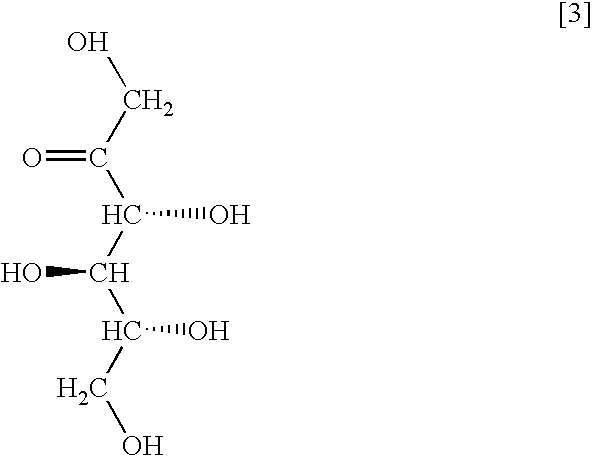Method for producing sugar alcohol
a technology of sugar alcohol and process, applied in the field of process for producing sugar alcohol, can solve the problems of difficult to obtain at a large amount, and achieve the effects of reducing the frequency of crystallization manipulation, facilitating the acquisition, and reducing the difficulty of alitol
- Summary
- Abstract
- Description
- Claims
- Application Information
AI Technical Summary
Benefits of technology
Problems solved by technology
Method used
Image
Examples
example 2
[0050] To a 1 L glass autoclave equipped with a stirrer and a thermometer, was added an aqueous solution containing 50 g of D-psicose, to which 30 g of platinum activated charcoal powder N1093C3 (manufactured by Nikki Chemical Co., Ltd.) was added. Water was thereafter added to adjust the total volume of the reaction mixture being 250 g. Then, calcium carbonate was added thereto to adjust the pH of the reaction mixture being 7. The reaction was conducted keeping the conditions of at the temperature of 40.degree. C., at the hydrogen pressure of 12 kg / cm.sup.2 (gauge pressure), and at the rate of stirring of 600 rpm. The analysis of D-psicose, D-talitol and alitol was performed using HPLC under similar conditions to those in Example 1. As a result, D-psicose decreased to 13% in the reaction of 17 hours, and to 0.3% in the reaction of 68 hours. The resulting production ratio of D-talitol and alitol was 35:65. Thereafter, the reaction mixture was filtrated through a 5C filter (manufactu...
example 3
[0051] To a 1L glass autoclave equipped with a stirrer and a thermometer, was added an aqueous solution containing 10 g of D-psicose, to which 2 g of 5% ruthenium carbon powder (manufactured by N E Chemcat Corporation) was added. Water was thereafter added to adjust the total volume of the reaction mixture being 200 g. Then, calcium carbonate was added thereto to adjust the pH of the reaction mixture being 7. The reaction was conducted keeping the conditions of at the temperature of 40.degree. C., at the hydrogen pressure of 12 kg / cm.sup.2 (gauge pressure), and at the rate of stirring of 400 rpm. The analysis of D-psicose, D-talitol and alitol was performed using HPLC under similar conditions to those in Example 1. As a result, D-psicose decreased to 63% in the reaction of 7.5 hours. The resulting production ratio of D-talitol and alitol was 62:38. Thereafter, the reaction mixture was filtrated through a 5C filter (manufactured by ADVANTEC, Inc.). Upon the analysis of thus resultant...
example 4
[0052] To a 1 L glass autoclave equipped with a stirrer and a thermometer, was added an aqueous solution containing 10 g of D-psicose, to which 30 g of platinum activated charcoal powder N1093C3 (manufactured by Nikki Chemical Co., Ltd.) and 0.05 g of cinchonidine were added. Water was thereafter added to adjust the total volume of the reaction mixture being 200 g. Then, calcium carbonate was added thereto to adjust the pH of the reaction mixture being 7. The reaction was conducted keeping the conditions of at the temperature of 40.degree. C., at the hydrogen pressure of 12 kg / cm.sup.2 (gauge pressure), and at the rate of stirring of 600 rpm. The analysis of D-psicose, D-talitol and alitol was performed using HPLC under similar conditions to those in Example 1. As a result, D-psicose decreased to 17% in the reaction of 17 hours, and to 1.7% in the reaction of 44 hours. The resulting production ratio of D-talitol and alitol was 31:69. Thereafter, the reaction mixture was filtrated th...
PUM
| Property | Measurement | Unit |
|---|---|---|
| Linear density | aaaaa | aaaaa |
| Angle | aaaaa | aaaaa |
| Fraction | aaaaa | aaaaa |
Abstract
Description
Claims
Application Information
 Login to View More
Login to View More - R&D
- Intellectual Property
- Life Sciences
- Materials
- Tech Scout
- Unparalleled Data Quality
- Higher Quality Content
- 60% Fewer Hallucinations
Browse by: Latest US Patents, China's latest patents, Technical Efficacy Thesaurus, Application Domain, Technology Topic, Popular Technical Reports.
© 2025 PatSnap. All rights reserved.Legal|Privacy policy|Modern Slavery Act Transparency Statement|Sitemap|About US| Contact US: help@patsnap.com


